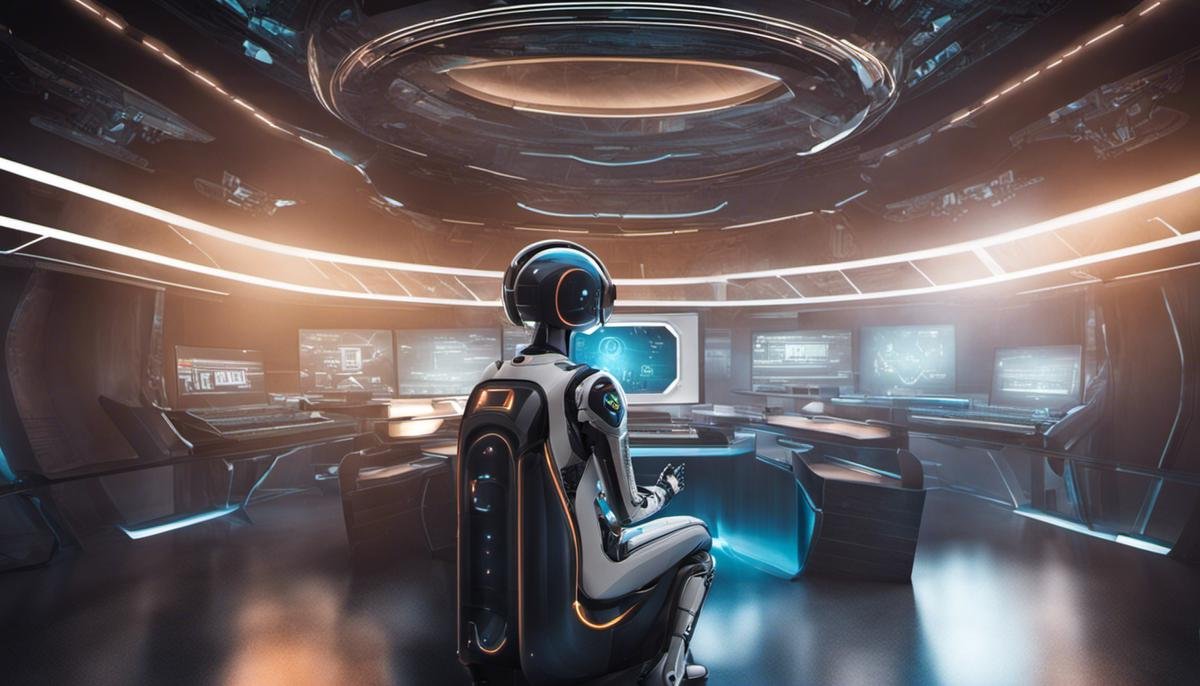With the continuous advancement of technology, a new realm of artificial intelligence has emerged and made a significant impact on our daily lives – Chatbots. These AI-powered entities have transformed the way businesses interact with their customers, making services more accessible, faster, and more personalized. In this exploration, we delve into the world of chatbots—understanding how they function, their role across various industries, their benefits and challenges, and their future potential.
What are Chatbots and How They Work
Chatbots: The Pinnacle of AI Communication
Chatbots are computer programs designed to interact with humans in natural language. The interactions can be both verbal and text-based, varying in complexity from simple scripted responses to more sophisticated machine learning implementations. The primary aim of chatbots is to simulate human conversation and provide immediate online customer support or assistance.
How Do Chatbots Function?
Chatbots work based on a combination of pre-calculated user phrases and artificial intelligence technologies. The tasks they perform are often based on scripts that are written and are then built upon as the AI learns more about the inputs it is receiving.
There are two main types of chatbots: rule-based and self-learning. The rule-based chatbots are operated under a set of pre-established rules, providing predefined responses based on the user’s input. On the other hand, self-learning bots utilize machine learning and natural language processing (NLP) to understand and respond to user inputs. These bots are capable of learning from past experiences and making conversations more personalized.
Natural Language Processing (NLP) plays a crucial role in this process. It is the AI’s ability to understand human language in its natural, everyday format. This is what enables chatbots to understand the user’s intent, irrespective of the language or syntax used.
The other significant technology underpinning chatbot operations is Machine Learning (ML). This allows chatbots to learn from past experiences. It applies this knowledge to future tasks, improving the quality of output over time, much like a human would learn from past experiences.
Chatbots in Action
Chatbots can be found in a wide range of applications. Many businesses utilize chatbots for customer service, allowing customers to ask questions or report problems 24/7. Online retailer sites often use them to help customers find what they are looking for.
A good example of a chatbot is Apple’s Siri, the voice-activated virtual assistant. Siri uses voice recognition and NLP to answer questions, make recommendations, and perform tasks for the user. Another prominent chatbot is Microsoft’s Cortana. By taking advantage of Bing’s extensive search capabilities and Office’s productivity features, Cortana provides personalized recommendations and proactive, pre-emptive assistance.
Exploring the Advantages and Limitations of Chatbots
Chatbots deliver remarkable advantages such as streamlining operations and providing consistent customer service. They efficiently handle simultaneous client interactions while offering round-the-clock visibility. However, no genuine innovation is without its drawbacks.
Despite these merits, chatbots can have some output limitations. They often grapple with complex requests or those that fall outside their pre-programmed capabilities. Additionally, some customers may still prefer traditional human interaction due to the affinity and subtlety that humans bring to the communication table.
Ultimately, chatbots serve as a compelling and adaptable component of AI technology that continues to prove its worth across various sectors, with customer service taking the lead. However, as with any technological advancement, their potency lies in recognizing and playing to their strengths while also acknowledging and working around their limitations.

The Role of Chatbots in Different Industries
The Rising Role of Chatbots in Healthcare
Emerging as an efficient tool in the healthcare sector, chatbots are being recognized for their adaptability and efficiency. They can be programmed to execute a multitude of tasks such as scheduling appointments, issuing health updates, and fielding patient inquiries. In addition, they can offer medical advice, send reminders for medication schedules, and provide mental health support. For example, the chatbot named “Tess” has been developed to deliver mental health therapy and another chatbot known as “Buoy Health” assists in diagnosing illnesses.
Chatbots in Retail
In retail, chatbots are transforming the shopping experience by offering personalized customer service. They are increasingly being used for customer engagement, addressing queries, recommending products, and processing orders. Trending retail chatbot examples include H&M’s chatbot on Kik and Messenger where customers can browse and buy products. Additionally, chatbots like eBay’s Shopbot can price products for sellers, locate items for buyers, and even suggest what to sell based on what’s trending.
The Chatbot Revolution in Customer Service
Chatbots have become an essential tool for enhancing customer service in various industries. They can assist customers around the clock, answering questions, resolving complaints, and providing detailed product information. Furthermore, they can quickly process large volumes of requests, making them more efficient than their human counterparts. Chatbot, GIA, developed by HDFC bank, answers customer queries about banking services, thus reducing wait time and enhancing customer experience.
Chatbots in Real Estate
In the real estate industry, chatbots play a pivotal role in lead generation and nurturing. They assist prospective customers by providing information about available properties, scheduling property visits, and answering inquiries, saving time for both clients and real estate professionals. Holmes, a chatbot specifically designed for real estate, matches users with available homes based on their preferences and can schedule meetings with realtors.
Chatbots in the Hospitality Industry
In the hospitality industry, chatbots enhance the guest experience by providing personalized service and quick responses to queries. They can assist with hotel bookings, offer travel advice, and provide local recommendations. For instance, Marriott International’s chatbot assists with reservations and rewards queries, while Expedia’s chatbot helps users with travel bookings.
Chatbots’ Role in the Education Sector
Chatbots are revolutionizing the education sector by facilitating personalized learning and addressing student queries. They can provide academic resources, help with course selection, remind students about assignment due dates, and more. For example, Georgia State University’s chatbot “Pounce” assists students with the enrollment process, thereby significantly reducing summer melt rates.
Chatbots, becoming increasingly essential in various sectors such as healthcare, retail, customer service, real estate, hospitality, and education, are noted for their capability to enhance efficiency and user experience. They also offer specialized service, thereby emphasizing their crucial role in the modern business landscape.

The Advantages and Challenges of Using Chatbots
Exploring the Benefits of Chatbots
Proven to be highly effective in the current digital age, chatbots, when appropriately programmed, can manage a variety of customer service tasks. This not only liberates employees to focus on more complicated, unique tasks, but also leads to substantial cost savings. Rather than sustaining a considerable customer service team, businesses can deploy chatbots to address routine queries, which in turn lowers operational costs.
Speaking of scalability, chatbots are highly flexible. A single bot can engage with one customer or thousands simultaneously without additional resources. This makes them especially useful for businesses undergoing rapid growth, as they can easily adapt to rising customer needs. Furthermore, when a chatbot is powered by machine learning algorithms, it can enhance its performance progressively.
One of the most attractive benefits of chatbots is their ability for personalized interaction. They can be programmed to recall customer preferences and interactions, offering a tailored and relevant user experience. This bespoke interaction can greatly boost customer satisfaction and loyalty, ultimately resulting in increased sales and profitability.
Challenges Faced in Adopting Chatbots
Chatbots undoubtedly bring many benefits to businesses, yet implementing them also presents a set of challenges. One of the primary difficulties lies in ensuring chatbots understand and respond to complex inquiries. While adept at handling straightforward questions, chatbots often lack the capacity to unravel and answer more nuanced requests, which could necessitate human intervention.
Another critical challenge is the issue of data privacy and security. Chatbots typically process delicate user information, making it crucial that this data is kept secure. Any breach in a chatbot’s security could potentially lead to significant data leaks, emphasizing the importance of implementing robust security measures in chatbot communication.
The lack of a human touch is another potential drawback of chatbots. Despite their many benefits, chatbots can disappoint users if they fail to reproduce the empathy and emotional understanding humans naturally integrate into conversations. This lack of personal interaction can be particularly frustrating for customers during stress-loaded situations or when they’re trying to resolve complex problems.
The process of creating and refining a chatbot is also complicated and continuous. Language nuances, cultural disparities, and dynamic customer preferences create regular challenges that require consistent fine-tuning. This demands a substantial sustained investment in both time and resources to keep the chatbot efficient and proficient.
In summary, while the benefits of chatbots are enormously advantageous for enhancing business functionalities and customer service quality, it’s important to keep potential challenges in mind. The implementation phase is crucial and should include an effective strategy for managing complex queries, bolstering security measures, and setting up a mechanism for steady learning and improvement.

The Future of Chatbots
Emerging Trends in Chatbot Technology
Looking ahead, chatbots are expected to become more sophisticated and efficient at interpreting human languages. Current chatbot models are primarily limited to fixed scripts. However, with the advancement in artificial intelligence (AI) and machine learning (ML) technologies, we can expect chatbots to better comprehend and respond to intricate language patterns. Essentially, this would equip chatbots to better understand the context and provide more tailored and precise responses.
Improvements in AI will also enable chatbots to evolve with every interaction. Thanks to machine learning algorithms, AI-integrated chatbots constantly process new data and optimize their responses based on prior exchanges. This allows them to “learn” from each interaction and gradually improve their responses, resulting in a more personalized user engagement with every proceeding interaction.
Impact on Customer Service Industry
The customer service industry is particularly susceptible to the enhancements in chatbot technology. Gartner predicts that by 2022, 85% of customer interactions will be managed without a human agent. The superior efficiency, availability, and consistency offered by AI-powered chatbots makes them an attractive option for businesses seeking to improve customer service, reduce costs, and streamline operations.
Moreover, advances in natural language processing (NLP) will also allow chatbots to simulate human conversation more realistically, enhancing the conversational experience for customers. They will be able to identify customer emotions and adjust their responses accordingly, thereby personalizing the customer experience.
Developments in Voice-Activated Chatbots
Voice-activated chatbots are poised to become a common feature in smart homes, boosting the IoT (Internet of Things) landscape. These chatbots can assist consumers in actions like playing music, controlling smart home devices, managing tasks, and providing informative responses – all through voice commands. With improving NLP and voice recognition technologies, we can expect these chatbots to understand and respond to a wider variety of commands and accents, thereby providing a smoother user experience.
Implications for Businesses
Businesses can leverage the advances in chatbot technology to significantly enhance their customer relationships. By providing personalized and prompt responses, chatbots can improve customer satisfaction and loyalty. On the operational side, they can help businesses handle high volumes of routine inquiries and transactions, enabling human staff to focus on more complex tasks. This will lead not just to cost savings, but also higher productivity and efficiency.
Additionally, chatbots can also be used to gather valuable consumer data and provide insights into consumer behavior. This can lead to improved products, services, and marketing strategies, thereby offering a competitive advantage to businesses.
Overall Outlook
Overall, the future for chatbots looks promising from both consumer and business perspectives. Advances in AI, ML, NLP, and other related technologies are set to significantly boost their capabilities, making them an essential instrument in the digital transformation journey of businesses.

The rise of chatbots signifies a major step towards personalized digital experiences. While there are challenges still to be faced, the advancements in AI and machine learning offer promising solutions that can greatly enhance the capability and efficiency of these digital assistants. As these technologies evolve, chatbots may well become ubiquitous in our daily lives, serving as our go-to resources for a myriad of services and tasks. The world of chatbots is still ripe with untapped potential, and this digital frontier only seems poised for more fascinating developments in the future.




